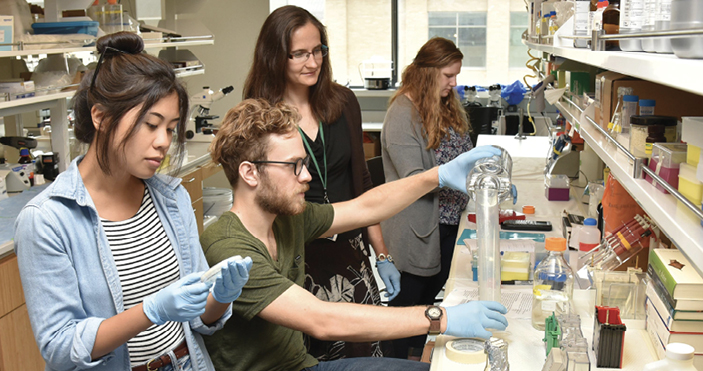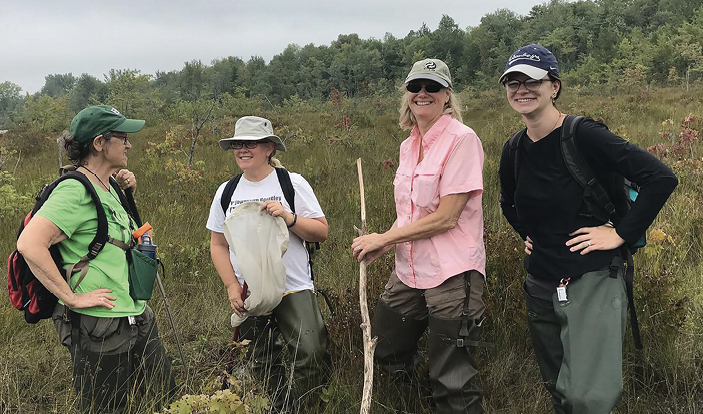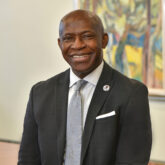
Yulia Artemenko (second from right), a biological sciences faculty member, supervised the lab work of biology majors (from left) Bianca Fernandez ’18, Jack Marcucci ’18 and Allison Hearn ’19 to study what triggers cells to migrate and to attach to a surface.
Cell Movement and the Spread of Cancer
Supported by a $300,000 National Science Foundation grant, undergraduate researchers are working with Dr. Yulia Artemenko of SUNY Oswego’s biological sciences faculty to investigate how single cells determine where to move, which could have implications for why cancer cells metastasize—migrate away from a primary tumor.
The three-year NSF Research in Undergraduate Institutions grant supports Artemenko’s and her students’ efforts to use a model organism, a social amoeba, to study the molecular pathways that allow cells to move in response to different triggers, as well as the role of cell attachment to a surface in recognizing some of those triggers. These processes are highly analogous to what happens to cells in humans with cancers and other diseases.

Among the scientists working to monitor and protect environmentally sensitive Oswego County habitats for threatened species are (from left) Sandra Bonanno, Karen Sime, Sandra Doran and Chelsea Springs ’18.
Fighting for Fens
SUNY Oswego faculty and student scientists are working to monitor and protect an environmentally sensitive Oswego County habitat of endangered species. They also plan to work with the Oswego County Soil and Water Conservation District to hold neighborhood education sessions about how people can alleviate some of the threats.
“We want residents of the area to understand there are things they can do to reduce their impact on the environment,” said SUNY Oswego Professor Peter Rosenbaum, lead investigator on a series of projects to monitor and mitigate threats to a fen that is home to rare species, their favored habitats and, increasingly, invasive species. Fens are marshy peat lands with a near-surface water table; groundwater and surface runoff keep them wet.
The county’s Soil and Water Conservation District administers a $150,000 Environmental Benefit Fund created by the state Department of Environmental Conservation to benefit these rare habitats and the threatened species. The fund supports five research projects and one education program. Investigators include biological sciences faculty members Richard Back, Eric Hellquist, Karen Sime and Rosenbaum, as well as independent ecologist Sandra Bonanno.
Smartphone Dependency
Computer science faculty member Caglar Yildrim researches nomophobia (fear of being without a smartphone) and other technology-related issues. His research agenda incorporates an interdisciplinary approach to studying how digital technologies affect human cognition, behavior and well-being, and how people can utilize digital technologies to actually support and promote human cognition and positive behavioral change, as well as improve overall well-being.
“That line of research includes some studies that actually look at how smartphone separation might affect our sustained attention performance,” he said. “So if you’re separated from your smartphone, are you thinking more about your smartphone and then that impacts your sustained attention performance or is it the other way around?”
More from Fall 2018
Tech & Marketing
Waves of Success A passion for weather and water led New York City native Jeff Ragovin ’00 to the shores of Lake Ontario. …
Rankings Round-Up
Top Regional Universities in the North SUNY Oswego has once again earned a top 50 ranking in the 2019 “Top Regional …
Welcoming Torchlight Ceremony Celebrates New Students, Most Diverse Class in History
College President Deborah F. Stanley, student speaker Boni Quatroche ’19, Student Association President Omar van Reenan ’19, Victoria Kammer ’20, faculty and staff …











